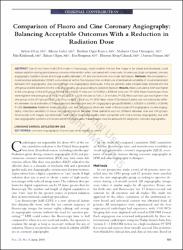| dc.contributor.author | Olcay, Ayhan | |
| dc.contributor.author | Güler, Ekrem | |
| dc.contributor.author | Karaca, İbrahim Oğuz | |
| dc.contributor.author | Omaygenç, Mehmet Onur | |
| dc.contributor.author | Kızılırmak, Filiz | |
| dc.contributor.author | Olgun, Erkam | |
| dc.contributor.author | Yenipınar, Esra | |
| dc.contributor.author | Çakmak, Hüseyin Altuǧ | |
| dc.contributor.author | Duman, Dursun | |
| dc.date.accessioned | 10.07.201910:49:13 | |
| dc.date.accessioned | 2019-07-10T19:58:23Z | |
| dc.date.available | 10.07.201910:49:13 | |
| dc.date.available | 2019-07-10T19:58:23Z | |
| dc.date.issued | 2015 | en_US |
| dc.identifier.citation | Olcay, A., Güler, E., Karaca, İ. O., Omaygenç, M. O., Kızılırmak, F., Olgun, E. ... Duman, D. (2015). Comparison of fluoro and cine coronary angiography: Balancing acceptable outcomes with a reduction in radiation dose. Journal of Invasive Cardiology, 27(4), 199-202. | en_US |
| dc.identifier.issn | 1042-3931 | |
| dc.identifier.issn | 1557-2501 | |
| dc.identifier.uri | https://hdl.handle.net/20.500.12511/3158 | |
| dc.description | WOS: 000362273800008 | en_US |
| dc.description | PubMed ID: 25840403 | en_US |
| dc.description.abstract | Use of last fluoro hold (LFH) mode in fluoroscopy, which enables the last live image to be saved and displayed, could reduce radiation during percutaneous coronary intervention when compared with cine mode. No previous study compared coronary angiography radiation doses and image quality between LFH and conventional cine mode techniques. Methods. We compared cumulative dose-area product (DAP), cumulative air kerma, fluoroscopy time, contrast use, interobserver variability of visual assessment between LFH angiography, and conventional cine angiography techniques. Forty-six patients were prospectively enrolled into the LFH group and 82 patients into the cine angiography group according to operator decision. Results. Mean cumulative DAP was higher in the cine group vs the LFH group (50058.98 +/- 53542.71 mGy.cm(2) vs 11349.2 +/- 8796.46 mGy.cm(2); P<.001). Mean fluoroscopy times were higher in the cine group vs the LFH group (3.87 +/- 5.08 minutes vs 1.66 +/- 1.51 minutes; P<.01). Mean contrast use was higher in the cine group vs the LFH group (112.07 +/- 43.79 cc vs 88.15 +/- 23.84 cc; P<.001). Mean value of Crombach's alpha was not statistically different between visual estimates of three operators between cine and LFH angiography groups (0.66680 +/- 0.19309 vs 0.54193 +/- 0.31046; P=.20). Conclusion. Radiation doses, contrast use, and fluoroscopy times are lower in fluoroscopic LFH angiography vs cine angiography. Interclass variability of visual stenosis estimation between three operators was not different between cine and LFH groups. Fluoroscopic LFH images conventionally have inferior diagnostic quality when compared with cine coronary angiography, but with new angiographic systems with improved LFH image quality, these images may be adequate for diagnostic coronary angiography. | en_US |
| dc.language.iso | eng | en_US |
| dc.publisher | HMP Communications | en_US |
| dc.rights | info:eu-repo/semantics/openAccess | en_US |
| dc.subject | Coronary Angiography | en_US |
| dc.subject | Fluoroscopy Time | en_US |
| dc.subject | Radiation Safety | en_US |
| dc.title | Comparison of fluoro and cine coronary angiography: Balancing acceptable outcomes with a reduction in radiation dose | en_US |
| dc.type | article | en_US |
| dc.relation.ispartof | Journal of Invasive Cardiology | en_US |
| dc.department | İstanbul Medipol Üniversitesi, Tıp Fakültesi, Dahili Tıp Bilimleri Bölümü, Kardiyoloji Ana Bilim Dalı | en_US |
| dc.authorid | 0000-0003-0525-6569 | en_US |
| dc.authorid | 0000-0002-4607-5724 | en_US |
| dc.authorid | 0000-0002-4281-0867 | en_US |
| dc.authorid | 0000-0003-2995-8792 | en_US |
| dc.authorid | 0000-0003-1919-3183 | en_US |
| dc.identifier.volume | 27 | en_US |
| dc.identifier.issue | 4 | en_US |
| dc.identifier.startpage | 200 | en_US |
| dc.identifier.endpage | 203 | en_US |
| dc.relation.publicationcategory | Makale - Uluslararası Hakemli Dergi - Kurum Öğretim Elemanı | en_US |
| dc.identifier.wosquality | Q4 | en_US |
| dc.identifier.scopusquality | Q2 | en_US |


















